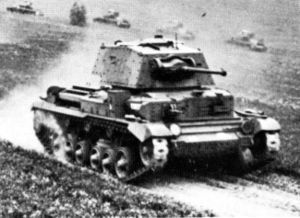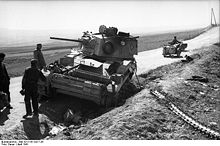- Cruiser Mk II
-
Tank, Cruiser, Mk II (A10) 
Type Cruiser tank Place of origin  United Kingdom
United KingdomService history In service 1940-1941 [1] Used by British Army Wars Second World War Production history Designer Sir John Carden Designed 1934 Manufacturer Vickers and others Produced 1938-1940 [1] Number built 175 Specifications Weight 14.3 tonnes Length 18 ft 4 in (5.5 m) Width 8 ft 4 in (2.6 m) Height 8 ft 8 in (2.5 m) Crew 5 (Commander, loader, gunner, driver, Hull MG gunner) Armour 6 - 30 mm Main
armamentOQF 2pdr
100 roundsSecondary
armamenttwo Vickers/BESA Machine guns
4,050 roundsEngine AEC Type A179 6-Cylinder Petrol
150 hpSuspension triple wheel bogie with coil spring Operational
range100 miles (road) Speed 16 mph (road)
8 mph (off-road)The Tank, Cruiser, Mk II (A10), was developed alongside the A9, and was intended to be a heavier, infantry tank version of that type. In practice it was not deemed suitable for the infantry tank role and was classified as a "heavy cruiser".
Contents
History and specifications
The A10 was developed by Sir John Carden of Vickers in 1934 by adaptation of the A9 design. The two sub-turrets present on the A9 were removed, and extra armour bolted onto that already present on the front and sides of the hull, along with all faces of the turret, providing approximately twice the armor in most areas. The A10 was two tonnes heavier than the A9, but used the same 150 bhp engine, and as a consequence the tank's top speed was cut from 25 mph to 16 mph.
The turret armament consisted of a QF 2-pounder (40mm) gun and a coaxial .303 Vickers machine gun. There was a 7.92mm BESA machine gun mounted in the hull in a barbette to the right of the driver. This was added to give extra firepower but at the expense of simplicity - the Vickers and the BESA using different ammunition. The tank had a total crew of five (Commander, gunner, loader, driver and hull machine gunner), and there was no separation between the driver's compartment and the fighting compartments.
It used the same suspension and engine as the A9 and as a result it was slower than the A9. The A10 entered service in December 1939, but was something of an oddity - it had been intended to sacrifice speed for armour like an Infantry tank, but was still relatively poorly armoured, and was, as a result, not effective. Production was ordered in July 1938, Total production was 175 vehicles including the 30 CS versions (see below), 45 were built by Birmingham Railway Carriage and Wagon Company, 45 by Metropolitan-Cammell, 10 by Vickers. In late 1939 another order was placed with Birmingham Railway Carriage and Wagon Company, this time it was a larger order of 75 vehicles.
Combat history
 A British Cruiser Mk II disabled by having lost a track (seen lower right) in Greece, 1941.
A British Cruiser Mk II disabled by having lost a track (seen lower right) in Greece, 1941.
A number of Mark IIs were part of the British Expeditionary Force (BEF) sent to France in the early stages of World War II. Their cross country performance was recorded as poor, but they were still used later in North Africa at the defence of Tobruk in 1941, where reliability and suspension performance in the desert conditions was praised. Sixty worn out examples were taken to Greece, by the 3rd Royal Tank Regiment and although they performed well against the German tanks, over 90% were lost due to mechanical breakdowns as opposed to enemy action (mainly tracks).[2][3]
Variants
Tank, Cruiser, Mk II (A10 Mk I)
Classified as a 'heavy cruiser' and 31 were sent to France with the 1st Armoured Division, but performed poorly in the following campaign. Also served in the North African Campaign until late in 1941.
Tank, Cruiser, Mk IIA (A10 Mk IA)
The coaxial Vickers machine guns were replaced with BESA machine guns. Armoured radio housing added.
Tank, Cruiser, Mk IIA CS (A10 Mk IA CS)
Had a 3.7" (94 mm) howitzer in the turret instead of the 2 pdr. The standard ammunition load was 40 rounds smoke, and a few HE shells. The CS denotes Close Support.
This weapon was derived from a World War I field howitzer. It was not related to the 3in howitzer used in later British tanks in World War II, which was itself replaced by a 95mm howitzer in the later versions of the Churchill infantry tanks and all CS versions of the Centaur and Cromwell cruiser tanks. There is a frequent and incorrect claim that the 3.7in CS gun only fired smoke shells due to reports that the A9 CS tanks that went to France only had smoke rounds.
Other vehicles based on chassis
See also
References
External links
Light tanks Cruiser tanks Mk I · Mk II · Mk III · Mk IV · Mk V Covenanter · Mk VI Crusader · Mk VII Cavalier · Mk VIII Centaur · Mk VIII Cromwell · Challenger · Comet · Sherman Firefly · Ram (Canada) · Grizzly I (Canada) · Sentinel (Australia)Infantry tanks Scout Cars and Armoured carsScout Cars Daimler Dingo • Dingo Scout Car (Australia) • Humber Scout Car • Lynx Scout Car (Canada) • S1 Scout Car (Australia)Light Reconnaissance Cars Armoured Cars AEC Armoured Car • Coventry Armoured Car • Daimler Armoured Car • Fox Armoured Car (Canada) • Guy Armoured Car • Humber Armoured Car • Lanchester Armoured Car • Marmon-Herrington Armoured Car (South Africa) • Morris CS9 • Rhino Heavy Armoured Car (Australia) • Rolls-Royce Armoured Car • Rover Light Armoured Car (Australia) • Standard Beaverette • Armoured Carrier Wheeled Indian Pattern (India)Armoured Trucks Bedford OXA • Armadillo • Bison • C15TA Armoured Truck (Canada) • Leyland Beaver-EelArmoured Command Vehicles Experimental vehiclesAvenger • Black Prince • Centurion • Excelsior • TOG 1 • TOG 2 • Tortoise • Valiant • Harry Hopkins • Alecto • Glanville Fighter Car • Morris Motors Salamander • Hillman Gnat • Schofield tank (New Zealand)Unarmoured vehiclesArtillery tractors Trucks and lorries Bedford QLD • Austin K2 • Morris 15 cwt • Austin K5 • Bedford OYD • Bedford OXD • Morris C9 • Guy Ant • Leyland Retriever (3-ton) • Leyland Lynx (30-cwt) • Leyland Hippo (10-ton) • Thornycroft Nubian • Thornycroft TartarTank transporters Utility and cars British armoured fighting vehicle production during World War II Interwar tanks- List
- Category
Tankettes - AMR 33
- AMR 35
- L3/33
- L3/35
- Carden Loyd
- T-27
- TKS
- Type 94 tankette
- Type 97 Te-Ke
- Tančík vz. 33
- AH-IV
Light - H35
- R35
- Fiat 3000
- Light Tanks Mk I–V
- Light Tank Mk VI
- M1 Combat Car
- M2 Light Tank
- Panzer I
- Panzer II
- LT vz. 34
- LT vz. 35
- LT vz. 38
- T-18
- T-26
- T-37
- T-38
- 7TP
- Type 92
- Vickers 6-Ton
Medium Cavalry, Cruiser or Fast - AMC 34
- AMC 35
- AMR 33
- AMR 35
- BT tank
- Cruiser Mk I
- Cruiser Mk II
- Cruiser Mk III
- SOMUA S35
Infantry Heavy Armoured Carriers Categories:- Cruiser tanks
- World War II tanks of the United Kingdom
- Vickers
Wikimedia Foundation. 2010.

